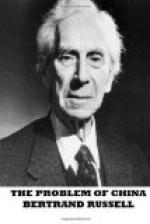The second kind of higher education in China is that initiated by the missionaries, and now almost entirely in the hands of the Americans. As everyone knows, America’s position in Chinese education was acquired through the Boxer indemnity. Most of the Powers, at that time, if their own account is to be believed, demanded a sum representing only actual loss and damage, but the Americans, according to their critics, demanded (and obtained) a vastly larger sum, of which they generously devoted the surplus to educating Chinese students, both in China and at American universities. This course of action has abundantly justified itself, both politically and commercially; a larger and larger number of posts in China go to men who have come under American influence, and who have come to believe that America is the one true friend of China among the Great Powers.
One may take as typical of American work three institutions of which I saw a certain amount: Tsing-Hua College (about ten miles from Peking), the Peking Union Medical College (connected with the Rockefeller Hospital), and the so-called Peking University.
Tsing-Hua College, delightfully situated at the foot of the Western hills, with a number of fine solid buildings,[97] in a good American style, owes its existence entirely to the Boxer indemnity money. It has an atmosphere exactly like that of a small American university, and a (Chinese) President who is an almost perfect reproduction of the American College President. The teachers are partly American, partly Chinese educated in America, and there tends to be more and more of the latter. As one enters the gates, one becomes aware of the presence of every virtue usually absent in China: cleanliness, punctuality, exactitude, efficiency. I had not much opportunity to judge of the teaching, but whatever I saw made me think that the institution was thorough and good. One great merit, which belongs to American institutions generally, is that the students are made to learn English. Chinese differs so profoundly from European languages that even with the most skilful translations a student who knows only Chinese cannot understand European ideas; therefore the learning of some European language is essential, and English is far the most familiar and useful throughout the Far East.




